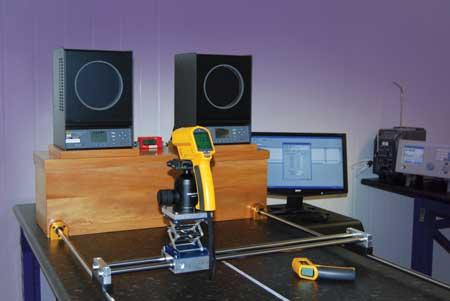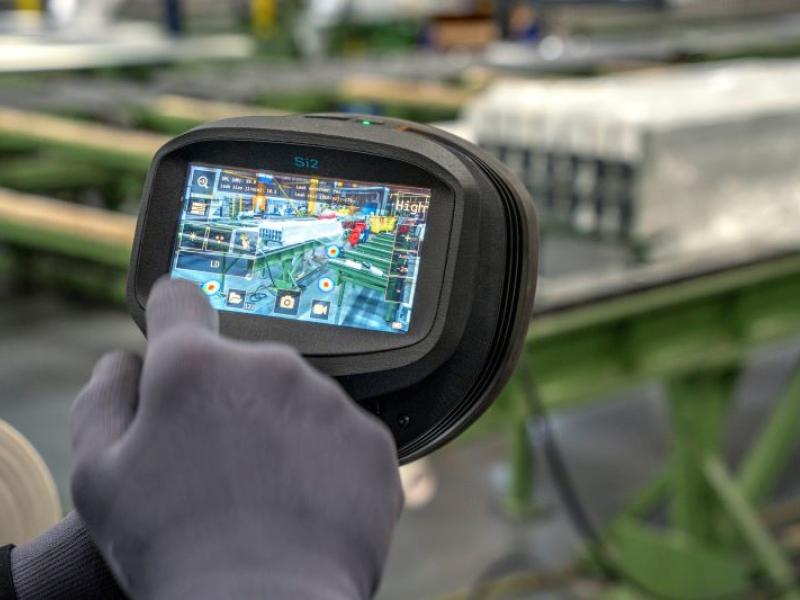Stefan Richter visited CPS, the first IANZ-accredited laboratory in New Zealand for the calibration of those cameras.
What’s the temperature in this area up there? 50ish? An accuracy like that might work in a kitchen environment, but when it comes to making important and sometimes expensive decisions about investments, maintenance schedules or shutdowns, you definitely want some more precision than that flowing into your decision making process. Kirsty Russell, CPS Laboratory Manager, recalls what happened when they talked to the attendees of a training course on thermal imaging about the necessity of having their cameras calibrated. “We took one of our IR black body calibrators out to the premises where the course took place so that people could test their cameras and see how much the readout varied from the reference temperature.” The temperature of the black body was set to 50ºC and about eight of the course attendees gave their thermal cameras a shot. “Everybody was expecting their cameras to read 50ºC, but how big was the surprise when some of the cameras actually measured 50.5 or 51ºC. One of the cameras even displayed more than 51ºC.”
CPS is an Onehunga-based supplier of calibration equipment. In 2011 it celebrated 25 years in business. The laboratory for the calibration of thermal imaging cameras was set up last year. “We got talking to one of the importers for the cameras and they said how they had to go to Australia for a check, and that check wasn’t even traceable,” says Chris Woudenberg, the Managing Director of CPS. “Therefore we decided to do it ourselves.” CPS worked closely together with the Measurement Standards Laboratory of New Zealand (MSL) for a couple of months to iron out and set up a state-of-the-art calibration laboratory and finally gained registration over a year ago. “And to this day we are the only ones in New Zealand and Australia who can offer this kind of service,” emphasises Chris Woudenberg.
CPS bought two precision IR black body calibrators from Fluke Calibration to create a standard every thermal imaging camera has to measure up to. Kirsty Russell takes the cap off one of the black bodies, sets the temperature to 40ºC, and, while waiting for the temperature to ramp up and stabilise, explains: “We use two of these black body calibrators in our laboratory. The first reaches temperatures from -15 to 120ºC, the other one offers a temperature range from 35 to 500ºC. Both emit a radiometrically calibrated IR radiation that serves as the reference for our measurements.” One of these calibrators was also taken out to the already mentioned training course.
Next Kirsty Russell takes a camera out of a drawer, securely mounts it on a platform and adjusts it to the right height so that it points directly at the centre of the black body’s face. “We test every camera at certain temperature points between -15 and 500ºC and at various distances up to three metres. When this test run is completed CPS uses all the readings obtained to calculate the measurement uncertainty of each set point rather than determining an overall uncertainty for the camera. “That way people can take the uncertainty at a specific distance and insert it into their calculation, which thereby becomes more accurate,” explains Chris Woudenberg. Meanwhile the black body temperature has stabilised at 40ºC, and a push on the camera trigger reveals a reading that is only slightly different to what it should be.
The calibration laboratory tests thermal imaging cameras to manufacturer’s specifications, but, in order to improve the accuracy for the user, also tries to emulate the operating conditions of each camera as closely as possible. “We ask every customer to fill in a checklist, detailing make and model of the camera, the types of objects usually measured, the measuring distance from the object and the emissivity value setting used,” says Kirsty Russell. “There is no point in testing a camera mainly at a distance of 0.5 metres when the user usually works at a distance of two metres or more.” At the end of the whole calibration procedure the customer is finally presented with an IANZ-endorsed certificate.
“We often find that people who use thermal imaging technology are unaware of the fact that they should have calibrated their cameras regularly. We recommend having it done every year,” says Chris Woudenberg. At the end of the day, you should not only be able to use a camera correctly, but also to count on what it is telling you. Out of the eight cameras at the earlier mentioned training course, only one had previously undergone calibration. “My experience tells me that there are still a lot of thermal imaging cameras out there that are not calibrated yet.
Email: kirsty@cps.co.nz






